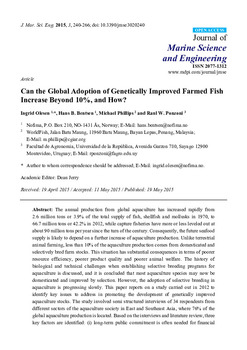Can the global adoption of genetically improved farmed fish increase beyond 10%, and how?

Citation
Olesen, I. et al. (2015). Can the global adoption of genetically improved farmed fish increase beyond 10%, and how?. Journal of Marine Science and Engineering, 3(2): 240-266
The annual production from global aquaculture has increased rapidly from 2.6 million tons or 3.9% of the total supply of fish, shellfish and mollusks in 1970, to 66.7 million tons or 42.2% in 2012, while capture fisheries have more or less leveled out at about 90 million tons per year since the turn of the century. Consequently, the future seafood supply is likely to depend on a further increase of aquaculture production. Unlike terrestrial animal farming, less than 10% of the aquaculture production comes from domesticated and selectively bred farm stocks. This situation has substantial consequences in terms of poorer resource efficiency, poorer product quality and poorer animal welfare. The history of biological and technical challenges when establishing selective breeding programs for aquaculture is discussed, and it is concluded that most aquaculture species may now be domesticated and improved by selection. However, the adoption of selective breeding in aquaculture is progressing slowly. This paper reports on a study carried out in 2012 to identify key issues to address in promoting the development of genetically improved aquaculture stocks.
Permalink
Date Available
Type
Publisher
Copyright
CC BY 4.0
Research Themes
Topics